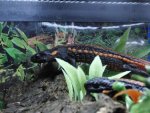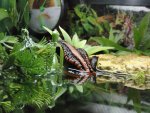Azhael
Site Contributor
- Joined
- May 7, 2007
- Messages
- 6,644
- Reaction score
- 121
- Points
- 0
- Location
- Burgos
- Country
- Spain
- Display Name
- Rodrigo
I see what you mean, thank you for taking the time to answer 
Although i understand your commentary about the criteria for species status being the same as for subspecies i´m not sure i can invalidate the concept of subspecies altogether. I´m thinking about something like some of the subspecies of I.alpestris. If there is geographical isolation (which there is) and there are minor morphological differences which are specific of each group, i can understand why that meets the criteria to consider them independent species, yet the differences seem so utterly insignificant (even though at a genetic level there may be more significant variations, despite the fact that they are not reproductively incompatible) that to consider them distinctive species sounds very tricky to me.
Take I.a.apuanus and I.a.cyreni, for example. They are geographically isolated, there is no gene flow whatsoever. They are distinctive from each other, both morphologically and genetically. Would you say these should be considered independent species? Again, i do understand why the criteria is the same, but i´m curious as to why you invalidate the concept of subspecies altogether (if that´s the case). I´d be interested to see what your reasoning is..let´s face it, i want to learn xDD
Sorry for deviating the topic and thank you for taking the time to satisfy my curiosity n_n I´m fascinated by taxonomy but i´m very green, so i really apreciate your input on the subject.
Although i understand your commentary about the criteria for species status being the same as for subspecies i´m not sure i can invalidate the concept of subspecies altogether. I´m thinking about something like some of the subspecies of I.alpestris. If there is geographical isolation (which there is) and there are minor morphological differences which are specific of each group, i can understand why that meets the criteria to consider them independent species, yet the differences seem so utterly insignificant (even though at a genetic level there may be more significant variations, despite the fact that they are not reproductively incompatible) that to consider them distinctive species sounds very tricky to me.
Take I.a.apuanus and I.a.cyreni, for example. They are geographically isolated, there is no gene flow whatsoever. They are distinctive from each other, both morphologically and genetically. Would you say these should be considered independent species? Again, i do understand why the criteria is the same, but i´m curious as to why you invalidate the concept of subspecies altogether (if that´s the case). I´d be interested to see what your reasoning is..let´s face it, i want to learn xDD
Sorry for deviating the topic and thank you for taking the time to satisfy my curiosity n_n I´m fascinated by taxonomy but i´m very green, so i really apreciate your input on the subject.


